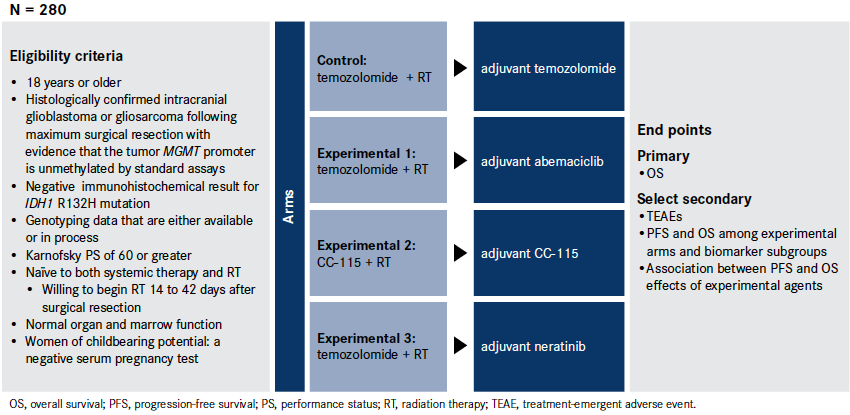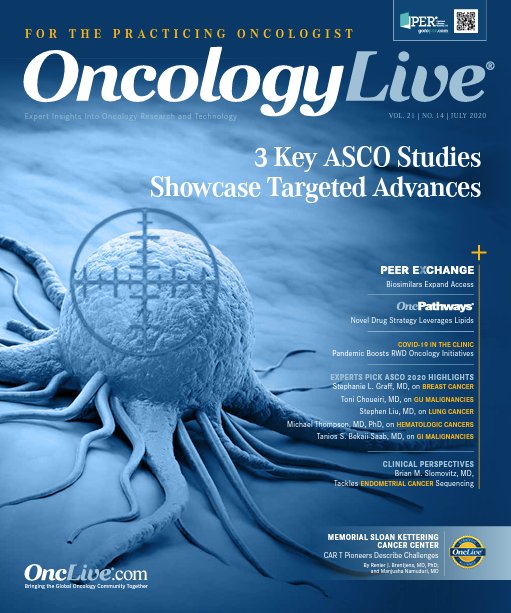Investigators Take Aim at GBM With a Biomarker-Driven Approach
Efforts are underway to expedite the identification of therapies that offer promise for patients with glioblastoma
Jan Drappatz, MD

Efforts are underway to expedite the identification of therapies that offer promise for patients with glioblastoma (GBM). Investigators of the phase 2 INdividualized Screening Trial of Innovative Glioblastoma Therapy (INSIGhT) study (NCT02977780) are using an adaptive platform trial (APT) design to move the needle in a disease that kills 95% of patients within 5 years of diagnosis.1,2
Motivated by the belief that the APT design is more conducive to testing therapeutic efficacy in GBM than the randomized control trial (RCT), INSIGhT investigators are enrolling 280 patients with newly diagnosed, unmethylated, IDH R132H–negative disease, who will be randomized 4:1 to the standard of care (SOC) control therapy or to an investigational therapy. To be eligible to participate, patients must have genotyping data that are either readily available or will soon become accessible, to enable investigators’ evaluation of patients’ positive or negative status for EGFR, PI3K, and CDK amplifications or mutations.2
“INSIGhT is a novel way of conducting a trial in the hope of more quickly identifying potential treatment options. The platform format is flexible and permits us to add other treatment arms that can be compared with the control arm,” said Jan Drappatz, MD, principal investigator of the trial’s site at the UPMC Hillman Cancer Center and associate professor of Neurology at the University of Pittsburgh School of Medicine, both in Pittsburgh, Pennsylvania.
The opportunity for adjustment that this approach affords investigators will be critical to new drug development in GBM, added Drappatz. The standard RCT can span 1 to 4 years in length; however, more than half of patients with GBM die within the first 15 months of GBM diagnosis.3 Further, in contrast with the RCT, the APT supports the simultaneous evaluation of multiple therapeutic and biomarkerbased hypotheses.
“The different arms of the INSIGhT trial are testing different molecularly targeted agents that target genomic subsets of GBM,” Drappatz said.
Initial randomization and enrollment will be equal across INSIGhT’s 4 arms, with 70 patients in each. As the trial progresses, randomization probabilities will adapt based on Bayesian estimation of the biomarker-specific probability of a therapy’s ability to confer a progression-free survival (PFS) benefit. The treatment arms that are not projected to improve PFS may be closed, and new, potentially more efficacious investigational arms may be added, increasing INSIGhT’s enrollment beyond 280 patients. This adaptive algorithm will update monthly.1
At present, INSIGhT includes 3 experimental arms. Patients randomized to arm 1 will receive SOC temozolomide (Temodar) in combination with radiotherapy (RT) for a maximum of 49 days, and adjuvant abemaciclib; arm 2, the mTOR inhibitor CC-115 plus RT, followed by CC-115 monotherapy; and arm 3, temozolomide and RT, with adjuvant neratinib (Nerlynx). Individuals in the control arm will be treated with temozolomide and RT, and adjuvant temozolomide. The primary end point is overall survival (OS). Secondary end points include treatment-emergent adverse events; PFS and OS among experimental arms and biomarker subgroups; and the association between PFS and OS effects of the investigational agents (Figure).4
Figure. Phase 2 INSIGhT Glioblastoma Trial (NCT02977780)4

Although concurrent temozolomide plus RT currently represents the SOC in GBM and has for several decades, the combination approach offers only a modest advantage.2 In individuals with unmethylated MGMT promoter, standard treatments offer virtually no benefit. “For patients with GBM with unmethylated MGMT promoter, current standard therapies move the needle by almost nothing. In this treatment-resistant patient subset, most of the benefit comes from radiation therapy, but temozolomide confers only very, very minimal benefits,” said Drappatz, who serves as the associate director of the Adult Neuro-Oncology Program at UPMC.
Continued efforts to advance the GBM paradigm, such as INSIGhT, are imperative to improving patient outcomes, particularly among patients with unmethylated disease, which is associated with poorer survival than methylated GBM. MGMT, a methyltransferase protein, is essential to repairing DNA damage. When the MGMT promoter is methylated, patients are more likely to respond to chemotherapy. However, MGMT is overexpressed in 60% of GBMs, resulting in resistance to alkylating chemotherapy agents such as temozolomide.5
“Long-term survival is essentially not possible for patients with unmethylated GBM,” said Drappatz, who added that the 2-year survival rates are 10% and approximately 50% for unmethylated and methylated disease, respectively. “Most patients relapse very quickly,” Drappatz said. “The average time to progression in unmethylated patients is 5 months, so these are patients who could receive a diagnosis in January and have already developed disease progression by May despite chemotherapy and radiation. These patients have a very high unmet need for [better] therapies.”
Development Biomarkers
Investigators of the INSIGhT study, led by Patrick Y. Wen, director of the Center for Neuro-Oncology at Dana-Farber Cancer Institute in Boston, Massachusetts, hope to develop biomarker data that can not only support the development of targeted therapies in GBM but also optimize precision medicine in this space. In contrast to other cancers with mutually exclusive driver mutations, GBM is characterized by redundant, overlapping alterations in multiple molecular pathways, causing patients with this disease to test positive for several biomarkers.2
INSIGhT will specifically study EGFR, CDK, and PIK3CA amplifications or mutations in its population to determine whether a patient’s positive status for any of these genetic abnormalities predicts patient response to any of the experimental agents under investigation. For example, abemaciclib, an anti–CDK4/6 agent that induces irreversible G1 phase cell-cycle arrest in retinoblastoma-proficient tumors, could be a suitable intervention for patients with a positive CDK result.1
Similarly, neratinib, an EGFR inhibitor that regulates cell growth and differentiation, 1 may emerge as a viable treatment option for patients with EGFR aberrations, which present in approximately 50% of patients and represent one of the molecular hallmarks of GBM, according to Drappatz. “The rationale is to block this driver mutation and determine whether these patients have a greater PFS benefit with neratinib compared with temozolomide,” he said.
CC-115 is a selective dual inhibitor of the mTOR kinases mTORC1 and mTORC2 and of DNA-dependent protein kinase; the latter is included among the PI3K-affiliated kinase subfamily of protein kinases and aids therepair of DNA double-stranded breaks.5,6 Notably, in GBM and in other malignancies, the PI3K/AKT/mTOR signaling axis fosters cell growth, survival, and metabolism. Beyond the possible antineoplastic activity of CC-115, the agent also has the potential to confer radiation-sensitivity in GBM, although it was not developed specifically for this disease.1
Although patients will initially be randomized equally across INSIGhT’s 4 treatment arms, the adaptive algorithm will incorporate any biomarker-specific survival benefit seen with the investigational therapies into its randomization procedure. For example, if monthly, updated INSIGhT data show that patients with EGFR amplification in the neratinib arm are living longer than patients with EGFR amplification in the control arm, the algorithm will increase the probability of EGFR-amplified patients’ assignment to the neratinib arm. It may also reduce the likelihood that patients with an EGFR wild-type result will be randomized to this arm.1
By assessing 3 common molecular targets in INSIGhT’s population and comparing the data from the trial’s 3 experimental arms with that of its control arm, investigators will be able to determine whether the investigational therapies better extend PFS versus temozolomide and RT. “It’s debatable if there is any benefit from temozolomide in patients with unmethylated MGMT,” Drappatz said. “INSIGhT is trying to identify targeted therapies that may work better than temozolomide.”
References:
- Alexander BM, Trippa L, Gaffey S, et al. Individualized screening trial of innovative glioblastoma therapy (INSIGhT): a Bayesian adaptive platform trial to develop precision medicines for patients with glioblastoma. JCO Precision Oncol. Published online March 27, 2019. doi:10.1200/PO.18.00071
- GBM AGILE. Global Coalition for Adaptive Research. Accessed June 26, 2020. https://www.gcaresearch.org/gbm-agile/
- Step 3: clinical research. FDA. Updated January 4, 2018. Accessed June 26, 2020. https://www.fda.gov/patients/drug-development-process/step-3-clinical-research
- INdividualized Screening Trial of Innovative Glioblastoma Therapy (INSIGhT). ClinicalTrials.gov. Updated February 26, 2020. Accessed June 26, 2020. https://clinicaltrials.gov/ct2/show/NCT02977780
- Taylor JW, Schiff D. Treatment considerations for MGMT-unmethylated glioblastoma. Curr Neurol Neurosci Rep. 2015;15(1):507. doi:10.1007/s11910-014-0507-z
- DNA-PK/TOR kinase inhibitor CC-115. National Cancer Institute Drug Dictionary. Accessed June 24, 2020. https://www.cancer.gov/publications/dictionaries/cancer-drug/def/dna-pk-tor-kinase-inhibitor-cc-115




